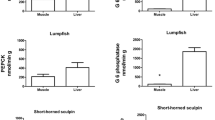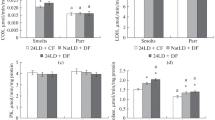Summary
-
1.
The metabolism of the glycolytic end product, octopine, was investigated in vivo in the cuttlefish,Sepia officinalis. Octopine was the major mantle muscle end product produced during hypoxia, exhaustive swimming, or exhaustive swimming followed by hypoxia (muscle octopine rose from 0.2 to 3.7, 8.6, and 13.4 μmol/g wet wt. respectively). Octopine concentration was inversely correlated with muscle glycogen and arginine phosphate concentrations and these substrates were almost completely depleted after swimming to exhaustion. Alanine, α-glycerophosphate, pyruvate, and malate were other, minor end products.
-
2.
Blood octopine (0.02 μmol/ml at rest), pyruvate, and alanine concentrations were elevated during hypoxia and during recovery from hypoxia or exercise but not during exercise itself. Maximal blood octopine concentrations were 8-fold higher than resting levels and blood octopine appeared to be derived from the release of muscle octopine into the bloodstream.
-
3.
14C-A-octopine (radiolabelled in the arginine moiety: N2-(1-carboxyethyl)[U-14C]L-arginine) was administered intravenously and tissue uptake patterns showed that mantle muscle was relatively poor at the uptake of blood14C-A-octopine while brain and ventricle rapidly concentrated the compound. Parallel experiments in which [U-14C]D-glucose or [U-14C]L-arginine were administered showed that there are distinct tissue specific uptake patterns for each of the three radiolabelled compounds.
-
4.
The tissue breakdown of14C-A-octopine taken up from the blood to form14C-arginine was found to be 0, 6, 32 and 20% respectively for mantle muscle, gill, ventricle, and brain. When delivered by specific injection into mantle muscle or brain,14C-A-octopine oxidation was 5% and 40% respectively after 20 min under resting, aerobic conditions.
-
5.
The data indicate that while mantle muscle readily produces octopine as a glycolytic end product, the tissue has little capacity for the oxidation of octopine. Muscle octopine appears to be released into the bloodstream and can be readily taken up by other tissues. The pyruvate moiety of octopine could be oxidized as an aerobic substrate by the Krebs cycle in tissues such as brain and ventricle with the arginine moiety being recycled to the muscle. The possible existence of a modified Cori cycle, to make use of octopine as a gluconeogenic substrate, is discussed.
Similar content being viewed by others
Abbreviations
- 14 C-A-octopine :
-
octopine radiolabelled in the arginine moiety; N2-(1-carboxyethyl) [U-14C)-l-arginine
- 14 C-P-octopine :
-
octopine labelled in the pyruvate moiety, N2-(1-[2-14C] carboxyethyl)l-arginine
References
Crowley, G.J., Moses, V., Ullrich, J.: A versatile solvent to replace phenol in the paper chromatography of radioactive intermediary metabolites. J. Chromatogr.12, 219–228 (1963)
Everse, J., Kaplan, N.O.: Lactate dehydrogenase: Structure and function. Adv. Enzymol.37, 61–148 (1973)
Fields, J.H.A., Baldwin, J., Hochachka, P.W.: On the role of octopine dehydrogenase in cephalopod mantle muscle metabolism. Can. J. Zool.54, 871–878 (1976)
Grieshaber, M., Gäde, G.: The biological role of octopine in the squid,Loligo vulgaris L. J. Comp. Physiol.108, 225–232 (1976)
Hiltz, D., Dyer, W.: Octopine in the postmortem adductor muscle of the sea scallop,Placopecten magellanicus. J. Fish. Res. Bd. Canada28, 869–874 (1971)
Hochachka, P.W., Moon, T.W., Mustafa, T., Storey, K.B.: Metabolic sources of power for mantle muscle of a fast swimming squid. Comp. Biochem. Physiol.52B, 151–158 (1975)
Hochachka, P.W., Hartline, P.W., Fields, J.H.A.: Octopine as an end product of anaerobic glycolysis in the chamberedNautilus. Science195, 72 (1977)
Keppler, D., Decker, K.: Glycogen: Determination with amyloglucosidase. In: Methods of Enzymatic Analysis. Bergmeyer, H.U., (ed.), pp. 1127–1131. New York: Academic Press 1974
Lowry, O.H., Passonneau, J.V.: A Flexible System of Enzymic Analysis, pp. 146–218. New York: Academic Press 1972
Regnouf, F., Thoai, N. van: Octopine and lactate dehydrogenases in mollusc muscles. Comp. Biochem. Physiol.32, 411–416 (1970)
Storey, K.B.: Tissue specific isozymes of octopine dehydrogenase in the cuttlefish,Sepia officinalis. The roles of octopine dehydrogenase and lactate dehydrogenase inSepia. J. Comp. Physiol.115, 159–169 (1977)
Storey, K.B., Hochachka, P.W.: Alpha-glycerophosphate dehydrogenase: its role in the control of the cytoplasmic arm of the alpha-glycerophosphate cycle in squid mantle. Comp. Biochem. Physiol.52B, 169–173 (1975)
Storey, K.B., Storey, J.M.: Energy metabolism in the mantle muscle of the squid,Loligo pealeii. J. Comp. Physiol.123, 169–175 (1978)
Storey, K.B., Storey, J.M.: Kinetic characterization of tissue-specific isozymes of octopine dehydrogenase from mantle muscle and brain ofSepia officinalis. Eur. J. Biochem.93, 545–552 (1979)
Author information
Authors and Affiliations
Rights and permissions
About this article
Cite this article
Storey, K.B., Storey, J.M. Octopine metabolism in the cuttlefish,Sepia officinalis: Octopine production by muscle and its role as an aerobic substrate for non-muscular tissues. J Comp Physiol B 131, 311–319 (1979). https://doi.org/10.1007/BF00688806
Accepted:
Issue Date:
DOI: https://doi.org/10.1007/BF00688806




